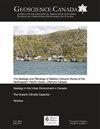The Jurassic Laberge Group in the Whitehorse Trough of the Canadian Cordillera: Using Detrital Mineral Geochronology and Thermochronology to Investigate Tectonic Evolution
IF 0.8
4区 地球科学
Q3 GEOSCIENCES, MULTIDISCIPLINARY
引用次数: 0
Abstract
The Laberge Group is an Early to Middle Jurassic sequence of mostly siliciclastic sedimentary rocks that were deposited in a marginal marine environment in the northern Canadian Cordillera. It forms a long narrow belt with a total thickness of 3–4 km extending for more than 600 km across southern Yukon and northwestern British Columbia. These sedimentary rocks overlap the Yukon-Tanana, Stikinia and Cache Creek terranes that form the main components of the Intermontane superterrane. The Laberge Group contains a record of the erosion of some of these terranes, and also offers some constraints on the timing of their amalgamation and accretion to the Laurentian margin. The Laberge Group was deposited with local unconformity on the Late Triassic Stuhini Group (in British Columbia) and correlative Lewes River Group (in Yukon), both of which are volcanic-rich, and assigned to the Stikinia terrane. The Laberge Group is in turn overlain by Middle Jurassic to Cretaceous clastic rocks, including the Bowser Lake Group in BC and the Tantalus Formation in Yukon. Clast compositions and detrital zircon populations within the Laberge Group and between it and these bounding units indicate major shifts in depositional environment, basin extent and detrital sources from Late Triassic to Late Jurassic. During the Early Jurassic clast compositions in the Laberge Group shifted from sediment- and volcanic-dominated to plutonic-dominated, and detrital zircon populations are dominated by grains that yield ages that approach or overlap their inferred depositional ages. This pattern is consistent with progressive dissection and unroofing of (an) active arc(s) to eventually expose Triassic to Jurassic plutonic suites. Detrital rutile and muscovite data from the Laberge Group indicate rapid cooling and then exhumation of adjoining metamorphic rocks during the Early Jurassic, allowing these to contribute detritus on a more local scale. The most likely source for such metamorphic detritus is within the Yukon-Tanana terrane, and its presence in the Laberge Group may constrain the timing of amalgamation and accretion of the Yukon-Tanana and Stikinia terranes. Thermochronological data also provide new insights into the evolution of the Laberge Group basin. Results from the U–Th/(He) method on detrital apatite suggest that most areas experienced post-depositional heating to 60°C or more, whereas U–Th/(He) results from detrital zircon show that heating to more than 200°C occurred on a more local scale. In detail, Laberge Group cooling and exhumation was at least in part structurally controlled, with more strongly heated areas situated in the footwall of an important regional fault system. The thermochronological data are preliminary, but they suggest potential to eventually constrain the kinematics and timing of inversion across the Laberge Group basin and may also have implications for its energy prospectivity. In summary, the Laberge Group is a complex package of sedimentary rocks developed in an active, evolving tectonic realm, and many questions remain about the details of its sources and evolution. Nevertheless, the available information demonstrates the potential of combined geochronological and thermochronological methods applied to detrital minerals to unravel links between regional tectonics, basin development and clastic sedimentation.加拿大科迪勒拉白马海槽侏罗纪Laberge群:用碎屑矿物年代学和热年代学研究构造演化
拉贝热群是早侏罗世至中侏罗世的一个序列,主要由硅化碎屑沉积岩组成,沉积在加拿大科迪勒拉北部的边缘海洋环境中。它形成了一条狭长带,总厚度为3-4公里,延伸600多公里,横跨育空地区南部和不列颠哥伦比亚省西北部。这些沉积岩与育空Tanana地体、Stikinia地体和Cache Creek地体重叠,这些地体构成了山间超地体的主要组成部分。拉贝热组记录了其中一些地体的侵蚀情况,并对其融合和向劳伦阶边缘增生的时间提出了一些限制。Laberge群是在晚三叠纪Stuhini群(不列颠哥伦比亚省)和相关的Lewes河群(育空地区)上局部不整合沉积的,这两个群都富含火山,属于Stikinia地体。拉贝热群又被侏罗纪中期至白垩纪的碎屑岩覆盖,包括不列颠哥伦比亚省的鲍泽湖群和育空地区的坦塔罗斯组。Laberge群内及其与这些边界单元之间的碎屑成分和碎屑锆石种群表明,从晚三叠纪到晚侏罗纪,沉积环境、盆地范围和碎屑来源发生了重大变化。早侏罗世,拉贝热群中的碎屑成分从沉积物和火山岩为主转变为深成岩为主,碎屑锆石种群以产生接近或重叠其推断沉积年龄的颗粒为主。这种模式与活动弧的逐渐剥离和展开相一致,最终暴露出三叠纪至侏罗纪的深成岩套。Laberge群的碎屑金红石和白云母数据表明,早侏罗世期间,毗邻变质岩迅速冷却,然后折返,使这些变质岩能够在更局部的范围内形成碎屑。这种变质碎屑最可能的来源是育空-塔纳那地体,其在拉贝热群中的存在可能会限制育空-塔那纳地体和斯蒂基尼亚地体的融合和增生时间。热年代学数据也为拉贝热群盆地的演化提供了新的见解。碎屑磷灰石的U–Th/(He)方法结果表明,大多数地区经历了沉积后加热至60°C或更高的温度,而碎屑锆石的U–Th/(He)结果表明,加热至200°C以上的温度发生在更局部的范围内。详细地说,拉贝热群的冷却和剥露至少在一定程度上受到了结构控制,更强烈的加热区域位于一个重要区域断层系统的下盘。热年代学数据是初步的,但它们表明有可能最终限制整个拉贝热群盆地的运动学和反演时间,也可能对其能源前景产生影响。总之,拉贝热群是在活跃、不断演化的构造领域中发育的一组复杂的沉积岩,其来源和演化细节仍有许多问题。然而,现有信息表明,将地质年代学和热年代学相结合的方法应用于碎屑矿物,有可能揭示区域构造、盆地发育和碎屑沉积之间的联系。
本文章由计算机程序翻译,如有差异,请以英文原文为准。
求助全文
约1分钟内获得全文
求助全文
来源期刊

Geoscience Canada
地学-地球科学综合
CiteScore
3.30
自引率
0.00%
发文量
9
审稿时长
>12 weeks
期刊介绍:
Established in 1974, Geoscience Canada is the main technical publication of the Geological Association of Canada (GAC). We are a quarterly journal that emphasizes diversity of material, and also the presentation of informative technical articles that can be understood not only by specialist research workers, but by non-specialists in other branches of the Earth Sciences. We aim to be a journal that you want to read, and which will leave you better informed, rather than more confused.
 求助内容:
求助内容: 应助结果提醒方式:
应助结果提醒方式:


